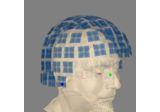mne.coreg.Coregistration#
- class mne.coreg.Coregistration(info, subject, subjects_dir=None, fiducials='auto', *, on_defects='raise')[source]#
Class for MRI<->head coregistration.
- Parameters:
- infoinstance of
Info|None The measurement info.
- subject
str The FreeSurfer subject name.
- subjects_dirpath-like |
None The path to the directory containing the FreeSurfer subjects reconstructions. If
None, defaults to theSUBJECTS_DIRenvironment variable.- fiducials
list|dict|str The fiducials given in the MRI (surface RAS) coordinate system. If a dictionary is provided, it must contain the keys
'lpa','rpa', and'nasion', with values being the respective coordinates in meters. If a list, it must be a list ofDigPointinstances as returned by themne.io.read_fiducials()function. If'estimated', the fiducials are derived from thefsaveragetemplate. If'auto'(default), tries to find the fiducials in a file with the canonical name ({subjects_dir}/{subject}/bem/{subject}-fiducials.fif) and if absent, falls back to'estimated'.- on_defects‘raise’ | ‘warn’ | ‘ignore’
What to do if the surface is found to have topological defects. Can be
'raise'(default) to raise an error,'warn'to emit a warning, or'ignore'to ignore when one or more defects are found. Note that a lot of computations in MNE-Python assume the surfaces to be topologically correct, topological defects may still make other computations (e.g.,mne.make_bem_modelandmne.make_bem_solution) fail irrespective of this parameter.New in v1.0.
- infoinstance of
- Attributes:
- fiducialsinstance of
DigMontage A montage containing the MRI fiducials.
transinstance ofTransformThe head->mri
Transform.
- fiducialsinstance of
Methods
Compute distance between head shape points and MRI skin surface.
fit_fiducials([lpa_weight, nasion_weight, ...])Find rotation and translation to fit all 3 fiducials.
fit_icp([n_iterations, lpa_weight, ...])Find MRI scaling, translation, and rotation to match HSP.
omit_head_shape_points(distance)Exclude head shape points that are far away from the MRI head.
reset()Reset all the parameters affecting the coregistration.
set_fid_match(match)Set the strategy for fitting anatomical landmark (fiducial) points.
set_grow_hair(value)Compensate for hair on the digitizer head shape.
set_rotation(rot)Set the rotation parameter.
set_scale(sca)Set the scale parameter.
set_scale_mode(scale_mode)Select how to fit the scale parameters.
set_translation(tra)Set the translation parameter.
See also
Notes
Internal computation quantities parameters are in the following units:
rotation are in radians
translation are in m
scale are in scale proportion
If using a scale mode, the
scale_mri()should be used to create a surrogate MRI subject with the proper scale factors.- compute_dig_mri_distances()[source]#
Compute distance between head shape points and MRI skin surface.
- Returns:
- dist
array, shape (n_points,) The distance of the head shape points to the MRI skin surface.
- dist
See also
Examples using
compute_dig_mri_distances:
- fit_fiducials(lpa_weight=1.0, nasion_weight=10.0, rpa_weight=1.0, verbose=None)[source]#
Find rotation and translation to fit all 3 fiducials.
- Parameters:
- lpa_weight
float Relative weight for LPA. The default value is 1.
- nasion_weight
float Relative weight for nasion. The default value is 10.
- rpa_weight
float Relative weight for RPA. The default value is 1.
- verbosebool |
str|int|None Control verbosity of the logging output. If
None, use the default verbosity level. See the logging documentation andmne.verbose()for details. Should only be passed as a keyword argument.
- lpa_weight
- Returns:
- self
Coregistration The modified Coregistration object.
- self
Examples using
fit_fiducials:
- fit_icp(n_iterations=20, lpa_weight=1.0, nasion_weight=10.0, rpa_weight=1.0, hsp_weight=1.0, eeg_weight=1.0, hpi_weight=1.0, callback=None, verbose=None)[source]#
Find MRI scaling, translation, and rotation to match HSP.
- Parameters:
- n_iterations
int Maximum number of iterations.
- lpa_weight
float Relative weight for LPA. The default value is 1.
- nasion_weight
float Relative weight for nasion. The default value is 10.
- rpa_weight
float Relative weight for RPA. The default value is 1.
- hsp_weight
float Relative weight for HSP. The default value is 1.
- eeg_weight
float Relative weight for EEG. The default value is 1.
- hpi_weight
float Relative weight for HPI. The default value is 1.
- callback
callable()|None A function to call on each iteration. Useful for status message updates. It will be passed the keyword arguments
iterationandn_iterations.- verbosebool |
str|int|None Control verbosity of the logging output. If
None, use the default verbosity level. See the logging documentation andmne.verbose()for details. Should only be passed as a keyword argument.
- n_iterations
- Returns:
- self
Coregistration The modified Coregistration object.
- self
Examples using
fit_icp:
- omit_head_shape_points(distance)[source]#
Exclude head shape points that are far away from the MRI head.
- Parameters:
- distance
float Exclude all points that are further away from the MRI head than this distance (in m.). A value of distance <= 0 excludes nothing.
- distance
- Returns:
- self
Coregistration The modified Coregistration object.
- self
Examples using
omit_head_shape_points:
- reset()[source]#
Reset all the parameters affecting the coregistration.
- Returns:
- self
Coregistration The modified Coregistration object.
- self
- set_fid_match(match)[source]#
Set the strategy for fitting anatomical landmark (fiducial) points.
- Parameters:
- match‘nearest’ | ‘matched’
Alignment strategy;
'nearest'aligns anatomical landmarks to any point on the head surface;'matched'aligns to the fiducial points in the MRI.
- Returns:
- self
Coregistration The modified Coregistration object.
- self
- set_grow_hair(value)[source]#
Compensate for hair on the digitizer head shape.
- Parameters:
- value
float Move the back of the MRI head outwards by
value(mm).
- value
- Returns:
- self
Coregistration The modified Coregistration object.
- self
- set_rotation(rot)[source]#
Set the rotation parameter.
- Parameters:
- rot
array, shape (3,) The rotation parameter (in radians).
- rot
- Returns:
- self
Coregistration The modified Coregistration object.
- self
- set_scale(sca)[source]#
Set the scale parameter.
- Parameters:
- sca
array, shape (3,) The scale parameter.
- sca
- Returns:
- self
Coregistration The modified Coregistration object.
- self
- set_scale_mode(scale_mode)[source]#
Select how to fit the scale parameters.
- Parameters:
- Returns:
- self
Coregistration The modified Coregistration object.
- self
Examples using
set_scale_mode:
- set_translation(tra)[source]#
Set the translation parameter.
- Parameters:
- tra
array, shape (3,) The translation parameter (in m.).
- tra
- Returns:
- self
Coregistration The modified Coregistration object.
- self
